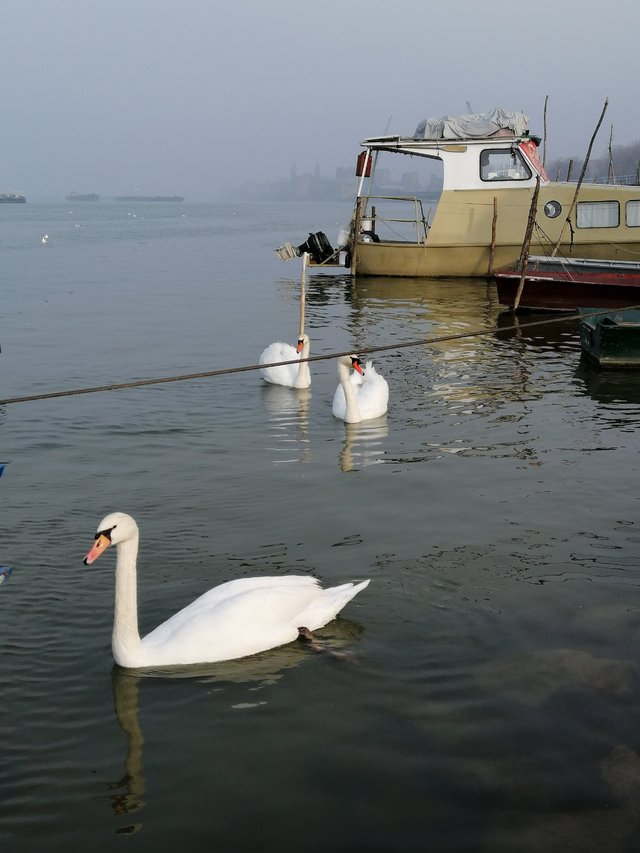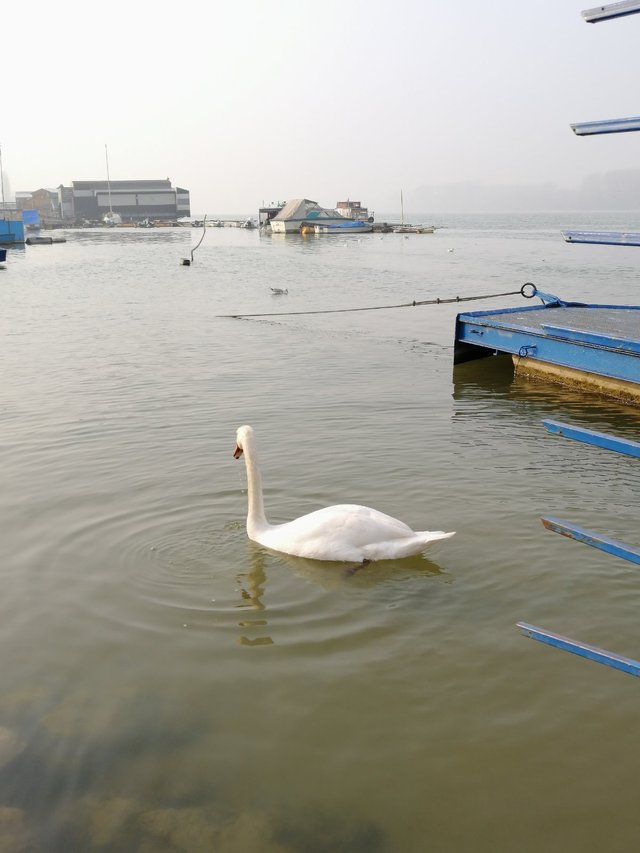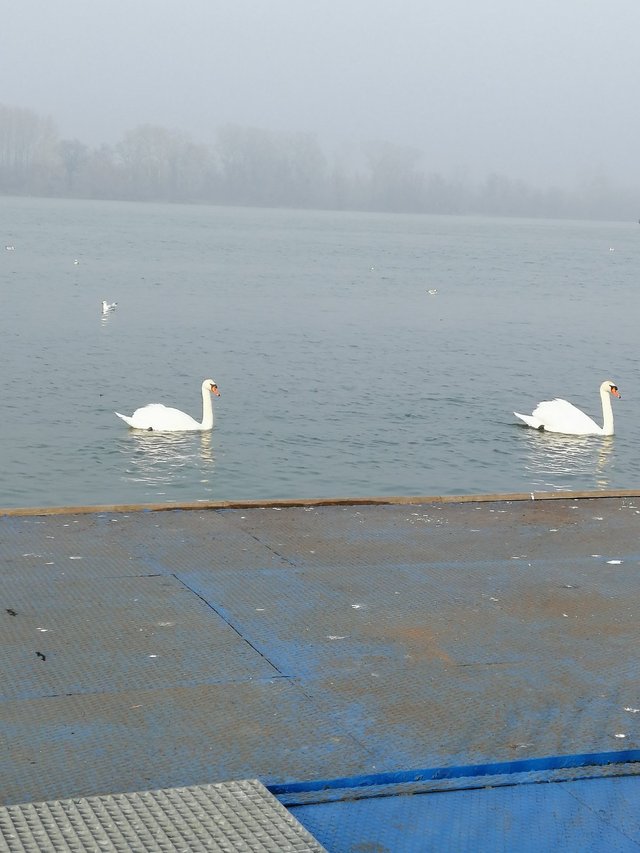Swans on a beautiful blue Danube🦢
I went for a walk on a foggy day. I was walking by the beautiful blue Danube. I saw beautiful white swans. I photographed them, and I decided to show them to you and say something about them.

Swans are the largest and most beautiful waterfowl. They symbolize LIGHT! Whenever I see them, I feel divine beauty, grace, inspiration ...
The Swans (Cybnini) are called two genera of birds from the order of duckweed. Within the order of the ducklings, the swans are part of the pancake subfamily.
The swan feathers are either completely white or a mixture of black and white, with the white variant sometimes having black wing tips. Black swans are the only black swan species. They have white wing tips and distinct red colored beaks. Males and females are always very similar, without gender dimorphism.
Swans in the narrow sense of the geese are distinguished by an even longer neck that allows them to search the bottom of deeper waters, and by the size of the body that makes them the largest waterfowl. Their wingspan can reach two feet and can weigh 15 pounds. Contrary to the wings, their legs are relatively short, so the swans on the ground seem rather clumsy. But they have very strong flight muscles, so they can fly more than a thousand kilometers to their nesting sites in the north.Both parents care for the cubs together. They stay with them for up to a year.
The swan life expectancy is very different. They range in age from 19 to 50, and sometimes much more than that.
The swan is a bird spoken of by many legends and with rich symbolic meanings in human tradition. According to the legend of becoming a world thought to date from the earliest cultures, the swan is a combination of air and water, essential elements for seed growth and development and vegetation restoration, thus symbolizing life itself.
As the embodiment of goodness and gentleness, the swan is present in the cultures of all nations. However, in some Indo-European myths, the swan also represents the opposite principle - the evil woman. The explanation for this myth goes much deeper and is linked to the (nightmare) symbol. The true meaning of the sea is that it is an evil goddess, who has the power to evoke the feeling of suffocation in the dream of animals and humans. In Indo-European mythology, evil women generally have the appearance of birds, so the sea is also represented as a woman from the "other" world, who took the form of a white bird (swan).

Beliefs
Among the myths about swans in the ancient Greeks, the most popular is the one about Zeus and Lady, who says Zeus saw Ice bathe in the river. To seduce her, Zeus took the form of a white swan. Leda couldn't be indifferent to the beauty of the white bird, so she fell in love, which was Zeus' goal.
Later, Leda laid two eggs. One cast out of the castors and Poluks twins, who became the brightest stars in the constellation of Gemini. The beautiful egg Helena hatched from another egg, which caused the war for Troy to break out. In the northern sky, there is a constellation of Swans of 6-7 glowing stars, arranged along the neck and spread wings of swans.
For the ancient Greeks there was a belief that the swan sings best before death itself, but not out of sorrow that it will die but with joy that, at any moment, is closer to the god with whom it will unite. The red-beaked swan, which can be seen more often in the southern parts of Europe, is a bird that, despite its beauty, does not emit other sounds besides hissing and hissing, which is why it is also called the mute swan. Then where did this belief come from? The explanation is this: the ancient Greeks probably did not distinguish between the red-beaked and the yellow-tailed swan and were not aware of the bird migration. This means that if they heard a swan singing, it was a yellow-haired, not a red-tailed swan. In addition, swans are generally residents of the northern parts of Europe and do not move to the warmer regions, as do swans and swarms, except when the waters freeze. Then they go a little further south in search of food, but with the first signs of spring they return to their habitat. It is likely that the Greeks noticed their periodic appearance, so they associated their departure from spring with a sad song, which they sing that they must die.On the walls of Hindu temples, a pair of swans are carved, kept alive in the midst of a blossoming lotus-knowledge, and are the symbol of the perfect union that all heavenly beings seek. In the Hindu faith, there is a belief that the supreme swan lays a golden universe egg from which Brahma emerged, and hence the swan is considered a holy, divine bird, a symbol of the holy spirit. Often, Brahma himself is portrayed riding a swan.
In ancient Egypt, the swan was believed to take the souls of the deceased into the world. With the Celts, the swan is the deity of the sun, mystical but benign. He is considered to have the healing power of the sun and that his song has magical powers.
The old Slavs believed that the swan represented the soul of the ancestors and that it could have divine and demonic qualities. The swans can be turned into fairies, able to move into falcons, wolves, snakes and other animals. Legend has it that there are three types of villas: mountain, water, and celestial. The latter have wings and can fly. If a person cheats and catches them, the only way to take away their power is to hide their wings. Their original essence was that the fairies are actually spirits of nature, because they know the language of fish and birds, they can heal wounds with different herbs, and in particular they can ease the misery and pain of the blind and the barren. Throughout history, fairies have been attributed to the power of union with ancestral souls. This is how the belief came about that they could take the form of any animal, and above all swans.

Swan and man
The swans always delighted the man with his gracefulness, handsome whiteness, and gentle appearance.
Artists have always been fascinated by the story of the swan song. Previously, it was assumed that this bird was overtaking its death and began to sing, however, scientists today found that it was something completely different. Although the swans' screaming can hardly be called a song, it's about their love game. It is less known that the swan's love life is very passionate. An in love couple is easily recognized in an undisclosed love game. It looks something like this: the female approaches first, and the male accepts her invitation if she elongates her body, which she will then do. Together they rot in the water and lean on each other to cling to their necks, which is a moment of complete surrender to one another.After all that play, the puppies come to their turn. They make nests on some floating island or ascension on the coast. When they hatch, they are not white but gray and remain so for up to a year - real ugly ducklings. The male is the careful guardian of his family and literally does not allow anyone to approach the female with swans. It is especially interesting how the couple is recognized in the crowd. Specifically, he distinguishes his fiancee from other long-haired beauties, believe it or not, in her beak and eyes, that is, in her face. Sometimes it happens that a swan, while furious looking for water plants, is attacked by her male, thinking that someone has entered his territory. Yet when she emerges and looks at him, he will begin to apologize, elongating his body.
The swans may look clumsy as they flick the water with their powerful wings to stand up slightly with their feet on its surface, but their graceful flight captivates the onlookers. Their love play and affection for one another are the true embodiment of romance and passion, but also eternal love. Maybe you could share some advice with us

Geese
Beliefs in swan legends are numerous and varied, and the real, biological life of swans is interesting and full of surprises. The courtship of the swans, for example, begins as early as the age of 1, when they are not yet fully white or mature. Most young swans live in a unique "fiancé" even after they mature, so they first nest in the third or fourth year. Once a couple has bonded, it stays together for life
Swans live mainly in latitudes with temperate and oceanic climates, in central and western European countries where they nest and spend most of their lives. During extremely cold winters, he sets out on a journey in search of unpowered rivers and lakes.
Swans belong to the order of the geese (Anseriformes), where they are the largest and largest birds. A genus of swans, Cygnus includes only four species, three of which nest in Europe. In our country, only one species, the red-tailed swan (Cygnus olor), which is a large and heavy bird, can be seen regularly, usually in winter. The male is slightly larger than the female, and the sexes do not differ in color or shape.Their heads are round and their necks are long and bent. The legs are black. The beak is reddish orange, serrated and edged with a black line all the way to the coat of arms at the base of the beak, which is why it is called the swan hump.
Adult specimens are completely white. The pups are gray-brown in color. During the first winter and spring, pups get more and more white feathers and begin to resemble their parents. They get full white feathers after the second year.
They are usually seen on the water, but they are also common in the blue meadows where they feed. They feed on aquatic vegetation up to a depth of not more than 1 m. They also occasionally find tiny animals such as frogs, tadpoles, snails, worms, insects and their larvae on the menu. They take off heavy wing movements and run across the surface of the water. All swans fly with their necks outstretched, even and slow in wing cover. The speed at which a swan can fly is 60-80 km / h. In the winter, they gather in flocks of one hundred and more specimens. In summer, flocks only gather non-nesting specimens.
A pair of red-beaked swans establish and defend their territory during the breeding season, in March or April. At that time, the males were very aggressive and vigorously rushed at any intruder entering their territory. The nest is built by both sexes, with the male bringing nest material and the female arranging and shaping it. Sometimes the same nest is used for several years. The nest is usually on the shore, near the water. The diameter of the nest a varies from 1 to 2 m and the height is 60-80 cm, but up to 4 m if the nest is on water. Only the nest is made of reeds, branches and various aquatic plants, and the interior is lined with soft herbs and feathers. Nest construction takes about 10 days. The female lays 5-8 pale green eggs at intervals of 48 hours. The eggs are blunt on both ends and coated with a lime tart until fresh. As the incubation period goes on, the eggs become scratched and get brown tufts. Only a female, 5-6 weeks old, is laid on the eggs, after which the swans hatch, ready to leave the nest immediately.

Swan-cobra
- There are many archeological traces about swan worship in our country as well. There is a bronze swan from Moses from the Bronze or Iron Age at the National Museum in Cacak. All features indicate the tame Cygnus olor swan.
The bones of the tame and wild swan Cygnus cygnus are found in prehistoric localities of Vojvodina, especially in the mounds, along the Tisa River. Apparently, the swans had a ritual role, but they also served as food. Today, swans are no longer eaten, but they are no longer breeding in our country.

Such beautiful swans! They are so white and bright, they stand out against any background.
Thanks for sharing these pictures and the information about Swans! :)
You're welcome.
Thank you for commenting on my posts :D
I like that you invested a lot of time in this post. I have never read so much information about the swans :) But I must say that I don't believe that Danube is blue. We have it in Bratislava and it looks like cappuccino :)
Thank you for sharing and congratulations on your curie vote!
Thank you. In our country sometimes the Danube is brown, blue and sometimes green. It changes color like a chameleon
That's interesting, I wonder why this is happening..
This post is super beautiful. You are very kind in writing scientific information about swans.
I think they are majestic birds that inspire positive messages.
A big hello @sarakey
Yes they are really beautiful white birds that spread positive energy and are not often seen here.
The color of the swans is so impressive, it looks so white and pure that you can see the brightest, also I like very much the guidelines about them because you tell me many things that I did not know. How beautiful to capture these photographs so elegant and full of life, this really relaxes and excites me, is a blessing to have them close. Congratulations and may they follow the best pictures for this community.
Greetings.
Thanks so much for this wonderful comment I did not know that this post impressed you and relaxed me so much.
Congratulations! Your post has been selected as a daily Steemit truffle! It is listed on rank 18 of all contributions awarded today. You can find the TOP DAILY TRUFFLE PICKS HERE.
I upvoted your contribution because to my mind your post is at least 4 SBD worth and should receive 208 votes. It's now up to the lovely Steemit community to make this come true.
I am
TrufflePig, an Artificial Intelligence Bot that helps minnows and content curators using Machine Learning. If you are curious how I select content, you can find an explanation here!Have a nice day and sincerely yours,

TrufflePighey dear @sarakey, your post is very beautiful and interesting !! swans are as beautiful as your photos and thank you for telling us so many fascinating details of mythology and beliefs about swans! congratulations on your work and the curie vote
Thanks a lot for the comment. I tried my best to tell you more about the swans.
Hi sarakey,
Visit curiesteem.com or join the Curie Discord community to learn more.
Excelente documental, los cisnes el cuento son unas de las especies mas delicadas, siempre recuerdo el cuento del patito feo quecuando creció se conviertió en un hermoso cisne.Te ha quedado muy bonita. El blanco del cisne con un buen balance y sobretodo con ese fondo azul desenfocado lo hace resaltar más la belleza de hermoso animal. Te felicito por tu buen arte. Mis saludos
Gracias por tus felicitaciones y por tu comentario :D
Beautiful documentary
Much to learn from swans, true family attachment.
I didn't know they lived so many years.
It is interesting the symbology and legends that have inspired this beautiful specimen.
Congrats on a Curie vote!